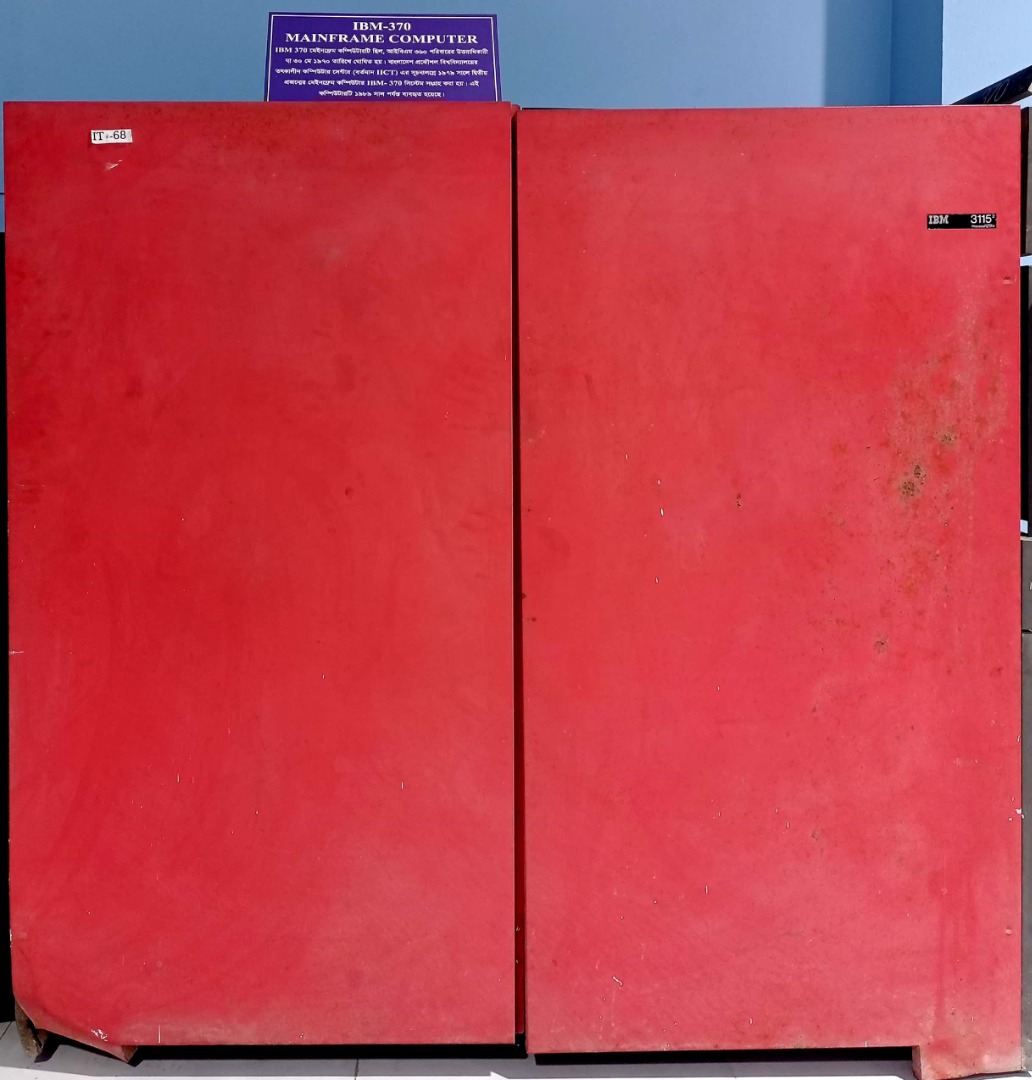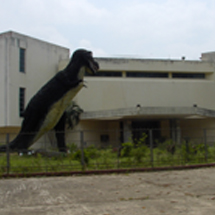আইবিএম ৩৭০
প্রকৌশল বিশ্ববিদ্যালয়ের তৎকালীন কমপিউটার সেন্টার (বর্তমান IICT) এর সূচনা লগ্নে ১৯৭৯ সালে ২য় প্রজন্মের মেইনফ্রেম কম্পিউটার আইবিএম ৩৭০ সিস্টেম সংগ্রহ করা হয়। শুরুতে এর মূল প্রসেসিং ইউনিটের(আইবিএম ৩১১৫) সংগে হার্ডডিস্ক এবং টেপ ইউনিট আইবিএম ৩৪১০ সংগ্রহ করা হয়। পরবর্তী সময়ে একটি কার্ডরিডার আইবিএম ৩৫০৫ এবং ডিস্কেট রিডার আইবিএম ৩৫৪০ সংগৃহীত হয়। প্রকৌশল বিশ্ববিদ্যালয়ের ছাত্র, শিক্ষক, গবেষকবৃন্দ ছাড়াও বিভিন্ন সরকারী ও বেসরকারী প্রতিষ্ঠানের ডাটা প্রক্রিয়াকরনের জন্য এই কম্পিউটার ব্যবহার করা হয়। আইবিএম ৩৭০ সিস্টেম ব্যবহারকারী উলেখযোগ্য কয়েকটি প্রতিষ্ঠান হলো বাংলাদেশ বিদ্যুৎ উন্নয়ন বোর্ড পিডিবি (বর্তমান ডেসা) বাংলাদেশ সরকারী কর্মকমিশন, জীবন বীমা করপোরেশন, আমেরিকান এক্সপ্রেস ব্যাংক, বাংলাদেশ ক্ষুদ্র কুটির শিল্প সংস্থা ইত্যাদি। এ কম্পিউটারটি ১৯৮৯ সাল পর্যন্ত ব্যবহৃত হয়।
নিচে উক্ত কম্পিউটারের বিভিন্ন অংশের বর্ণনা দেয়া হল
আইবিএম ৩৩৪০ (ডিস্ক স্টোরেজ,৪টি)
এটি হার্ডডিস্ক। প্রত্যেকটি হার্ডডিস্কের কার্যক্ষমতা ৭২০ মেগাবাইট।
আইবিএম ৩৪১০(ম্যাগনেটিক টেপ ইউনিট,৩ টি)
এটি ৯ ট্র্যাক স্পুলটাইপ ম্যাগনেটিক টেপ পড়ার ইউনিট। এটি ৮০০ ও ১৬০০ বিপিআই ঘনত্বের ম্যাগনেটিক টেপ পড়তে ও লিখতে সক্ষম।
আইবিএম ৩৫০৫(কার্ড রিডার)
পাঞ্চকার্ড রিডারটি শুরুতে এই কম্পিউটারের একমাত্র ইনপুট ডিভাইস হিসাবে কাজ করতো । ৮০ কলাম বিশিষ্ট বিশেষ কার্ড এর মাধ্যমে ডাটা ইনপুট দেওয়া হতো।
আইবিএম ৩৫৪০(ডিস্কেট রিডার)
এটি কম্পিউটারের ইনপুট ডিভাইস হিসাবে কাজ করতো। ডিস্কেট রিডার সংগৃহীত হবার পর কয়েকটি অফলাইন ডাটা এন্ট্রি ইউনিট সংগ্রহ করা হয়। ডাটা এন্ট্রি ইউনিটে বসে ব্যবহারকারী তার সুবিধা মত সময়ে ডিস্কেটে প্রোগ্রাম ও ডাটা এন্ট্রি করতো। এই ডিস্কেট (৮ ইঞ্চি) পরবর্তী সময়ে ৩৫৪০ রিডারে ব্যাচ মোডে(একটির পরে একটি) হিসাবে প্রসেস করা হতো । সিস্টেমের অপারেটররা এগুলো চালাতেন। প্রোগ্রাম চালানোর জন্য বিশেষ জব কন্ট্রোল কমান্ড ব্যবহার করা হতো।

The IBM System/370 (S/370) was a model range of IBM mainframes announced on June 30, 1970 as the successors to the System/360 family. The series maintained backward compatibility with the S/360, allowing an easy migration path for customers; this, plus improved performance, were the dominant themes of the product announcement. Improvements over the S/360 first released in the S/370 model range included:
- standard dual-processor capability;
- "monolithic main memory" based on integrated circuits instead of magnetic cores;
- full support for virtual memory through a new microcode floppy disk on the 370/145 and a hardware upgrade to include a DAT box on the 370/155 and 370/165; these were not announced until 1972;
- 128-bit floating point arithmetic.
This second generation mainframe computer, IBM 370 system was collected on 1979 on the eve of the Computer Centre of the then of Bangladesh University of Engineering & Technology(BUET) (currently known as IICT). At the beginning, hard disks and tape units along with the main processing unit were collected. Next time, a card reader, IBM 3505 and a diskette reader, IBM 3540 were collected. In addition to the students, teachers & researchers of the engineering university, this computer was used in data processing for various government & non-government organisations. Some important IBM 370 system user organisations were Bangladesh Power Development Board BPDB, Bangladesh Public Service Commission, Life Insurance Corporation, American Express Bank, Bangladesh Small and Cottage Industries Organization. This computer was used until 1989..This computer was donated by Bangladesh University of Engineering & Technology on 2001.The descriptions of the different parts of the computer are given below:
IBM 3340, Disk Storage Drive
The IBM 3340 Direct Access Storage Facility, code-named Winchester, was introduced in March 1973 for use with IBM System/370. Its removable disk packs were sealed and included the head and arm assembly. There was no cover to remove during the insertion process. Access time was 25 millisecond and data transferred at 885 KB/s. Three versions of the removable IBM 3340 Data Module were sold, one with 35 megabyte capacity, another with 70 megabytes, the third also had 70 megabytes, but with 500 kilobytes under separate fixed heads for faster access.
IBM 3410, Magnetic Tape Unit
The IBM 3410 magnetic tape subsystem was used not only with the IBM System/360 and System/370 mainframes but also extended tape storage capability to the small IBM System/3 for the first time. The 3410 subsystem had a new, desk-high design with tape reels mounted horizontally instead of vertically, as in most tape drives. A transparent sliding cover similar to that of a roll top desk provided easy access. Control circuitry for as many as six tape drives was built into one of the tape units, eliminating the need for a separate control unit and saving floor space. Servicing was performed from the front, so that drives could be placed as close to a wall as six inches.The 3410 could read or record data on magnetic tape at 20,000, 40,000 or 80,000 bytes a second. Major features included:Advanced monolithic circuit technology in both the control unit and tape drives.Dual density, the ability to use tapes recorded at different densities on the same drive.An optical tachometer that made possible precise control of the speed of the capstan and associated tape motion.Micro diagnostic programs in the control unit that simplified and sped servicing. Simplified tape threading and a push/pull, quick release mounting hub, permitting fast loading and unloading of standard tape reels.
IBM 3505, Card Reader
The 3505 subsystem consists of an 80 column card reader and card punch that attaches to the IBM 370 system. The subsystem is designed to provide increased customer availability by reduction of service time and autos retry capabilities. The 3505 is a serial card reader using an optical read system.
IBM 3540, Diskette Reader
IBM 3540 Diskette Input/Output unit is a standalone disk drive which attaches to system 370s with virtual capabilities. It provides direct system input from or output to the new IBM diskette (8”).


.jpg)













